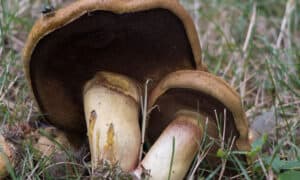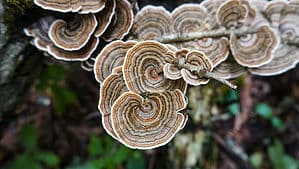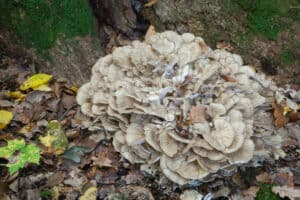While you can find mushrooms in all colors of the rainbow, it’s extremely common to come across brown mushrooms. If you’re interested in mushroom foraging, you may be familiar with the phrase “little brown mushrooms” or “lbm”. This phrase refers to the hundreds of species of small brown mushrooms, especially gilled specimens. Many of these mushrooms are often extremely difficult or even impossible to accurately identify down to the species from looks alone.
However, some brown mushroom species fall outside of the little brown mushroom category and are easier to identify. Some of these species are also quite delicious, and some are being studied for potential medicinal uses. You can find brown mushrooms that are edible and easier to identify across a range of orders of fungi.
In this guide, we’ll discuss four species of brown mushrooms, their fungal classification, native ranges, ecological niches, how to identify them, and their uses.
So, without further ado, let’s jump in!
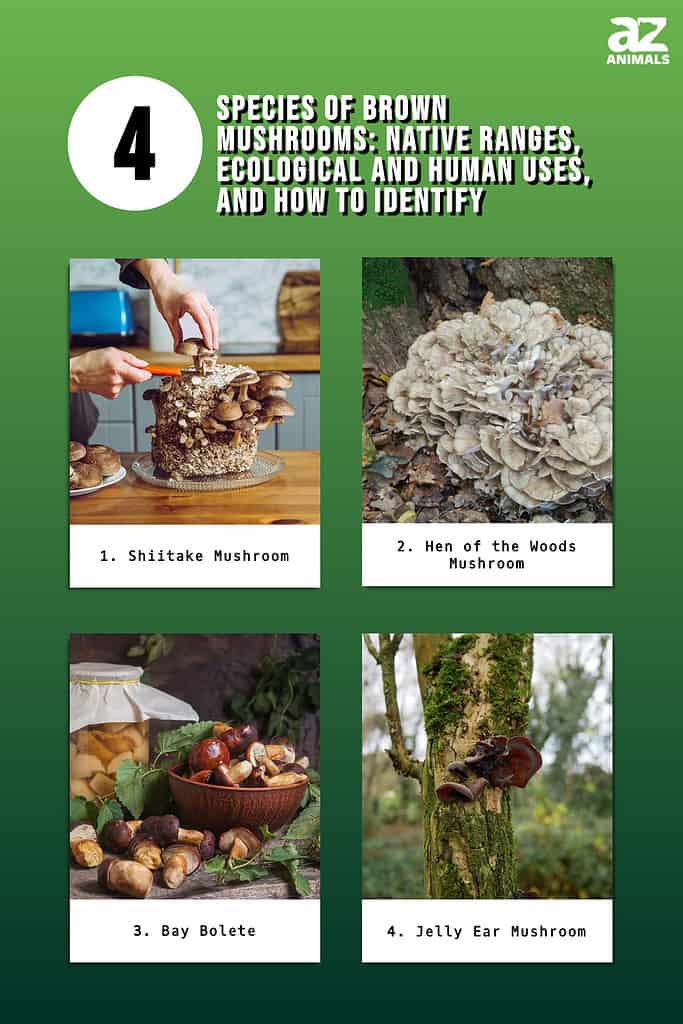
4 Species of Brown Mushrooms: Native Ranges, Ecological and Human Uses, and How to Identify
As with foraging for any wild mushroom, when searching for the following species of brown mushrooms, it’s crucial to confirm with 100% certainty the identity of the mushroom before consumption. Since some folks can have gastrointestinal upset with confirmed edible mushrooms, if you haven’t eaten a particular species before, it’s best to thoroughly cook a bite-sized portion of the mushroom and wait 24 hours before consuming more. If you aren’t an experienced mushroom hunter, it’s always best practice to accompany a mushroom expert on foraging excursions. Joining a local mushroom club can help you get connected.
1. Types of Brown Mushrooms: Shiitake Mushroom (Lentinula edodes)
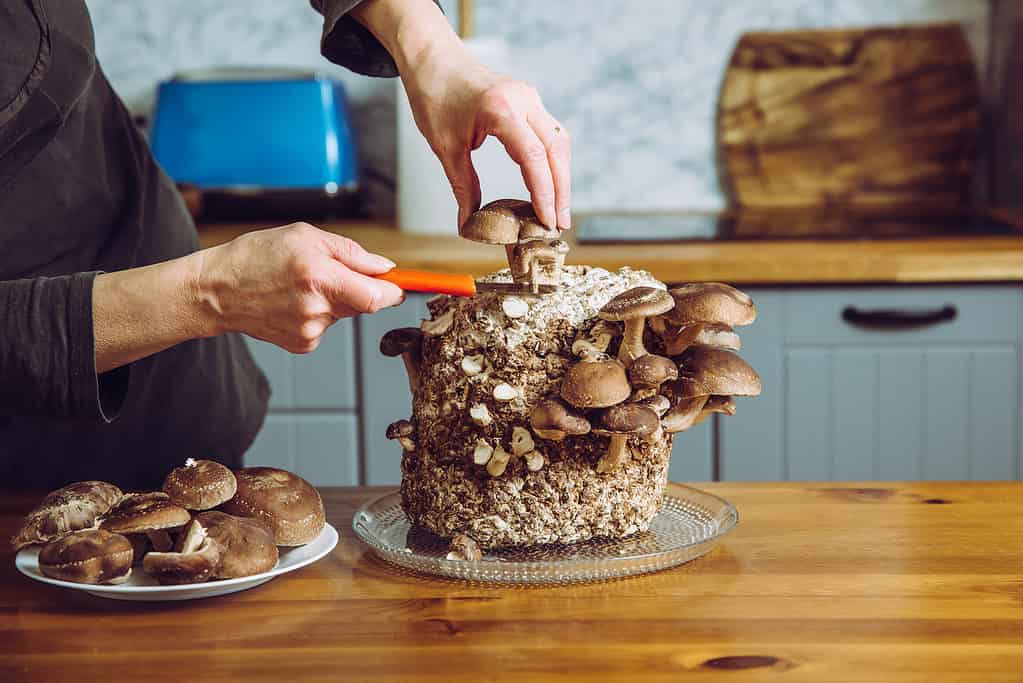
Shiitake mushrooms are well-loved for their chewy, meaty texture and rich, umami flavor.
©FotoHelin/Shutterstock.com
A choice edible mushroom, the shiitake mushroom (Lentinula edodes) is currently the second most cultivated mushroom in the world. A saprotrophic species, this mushroom is a white-rot fungus, capable of decomposing the cellulose, hemicellulose, and lignin in wood, although they tend to primarily target lignin. This decomposition allows essential nutrients to return to the soil and for the mushroom to obtain carbon from the wood for food and cellular growth.
Widely popular in a plethora of cuisines, shiitake mushrooms are well-loved for their chewy, meaty texture and rich, umami flavor. In addition to its ecological role and culinary value, many studies have demonstrated various, potentially health-benefiting properties of Lentinula edodes. For example, some research indicates antimicrobial, antitumor, and immunomodulating effects.
To identify: Native to temperate regions of East Asia, folks in these areas can find shiitakes growing wild in the spring and fall on hardwood logs in cool-to-warm, forested locations. They have also naturalized themselves, escaping from cultivators, in certain parts of North America. Most people in the U.S. just buy them from the grocery store or grow them at home, but they are possible to find. To identify shiitakes, look on downed hardwood logs for stem-and-cap, gilled mushrooms with brown, almost rubbery-feeling caps, and cream to light brown stems (often called a stipe in mycology).
The gills are cream-colored and crowded, and the spore print is white. No milky substance should secrete from the gills when pressed. The cap often has a cracked, scaly appearance, and the edges of the cap roll inwards. The stipe is usually thin and may also appear scaly. The flesh of the shiitake mushroom is cream-colored, bruising brown when pressed.
2. Hen of the Woods Mushroom (Grifola frondosa)
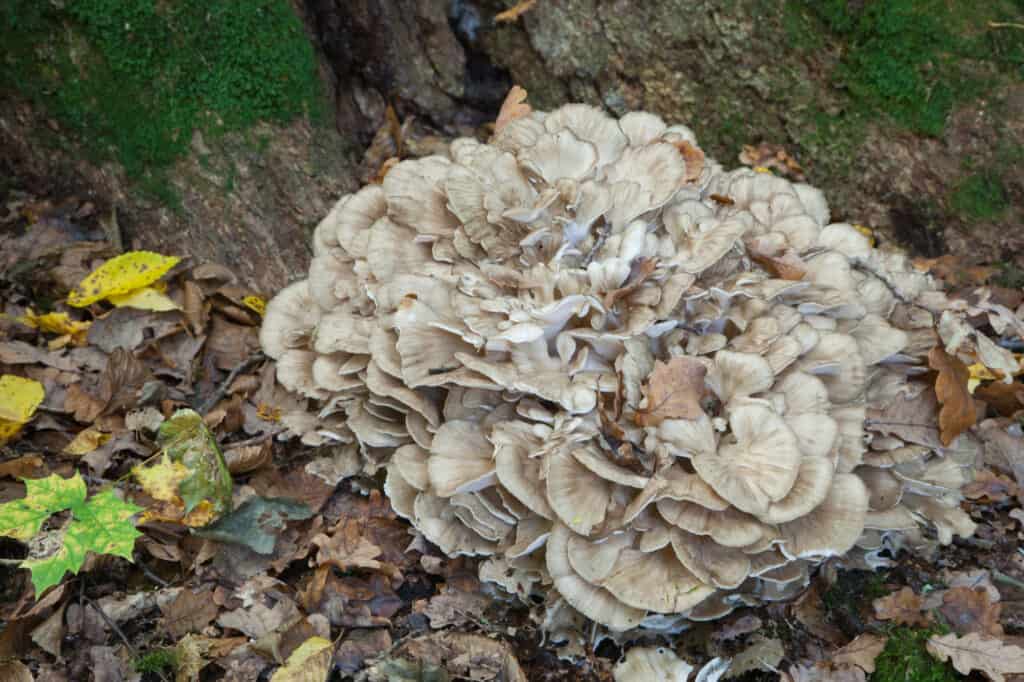
If left alone, hen of the woods mushrooms can grow quite large.
©Aleksander Bolbot/Shutterstock.com
Hen of the woods mushroom, or maitake (Grifola frondosa) is a delightful polypore mushroom that is weakly parasitic and can cause a white butt rot at the base of predominantly oak trees. this fungus typically only causes mild damage to the tree, however, and also behaves as a saprobe on already dead trees. As a saprotrophic mushroom, hen of the woods is a white-rot fungus, able to decay both cellulose and lignin in the hardwood.
This mushroom is popular for pan frying or roasting and makes an excellent meat substitute. A common recipe involves sizzling the tender parts in sage, butter, garlic, and a dash of wine. Additionally, research indicates that Grifola frondosa contains several polysaccharides that are potentially beneficial to our health. Studies show these compounds contain numerous bioactive effects including anti-inflammation, immunomodulation, antitumor, hypoglycemic, antioxidant, and antivirus.
To identify: This choice edible mushroom is native to temperate, arboreal regions of Asia, Europe, and Eastern North America. It occurs from late summer through fall at the base of hardwoods, predominantly oak. It grows in clusters of lobed, fan-like fruiting bodies with wavy margins. Hen of the woods is a bracket fungus and contains one thick, central stem from which many caps branch. The cap color ranges from grey-brown to light brown. As a polypore bracket fungus, the underside of the cap contains pores rather than gills. The lavender-grey to white or yellowish (when old) pores often run down the stipe almost to the base of the fungus. The flesh is firm to tough towards the base and white. It does not change color when cut or exposed to air.
The entire fruiting body cluster can grow quite large, with some reaching up to 60 inches across and weighing up to 100 pounds. Although a more typical size is up to 30 inches across and between 5-30 pounds. A knife will definitely come in handy when harvesting this fungus. Know ahead of time that you might find some bugs inside when processing.
3. Types of Brown Mushrooms: Bay Bolete (Imleria badia)
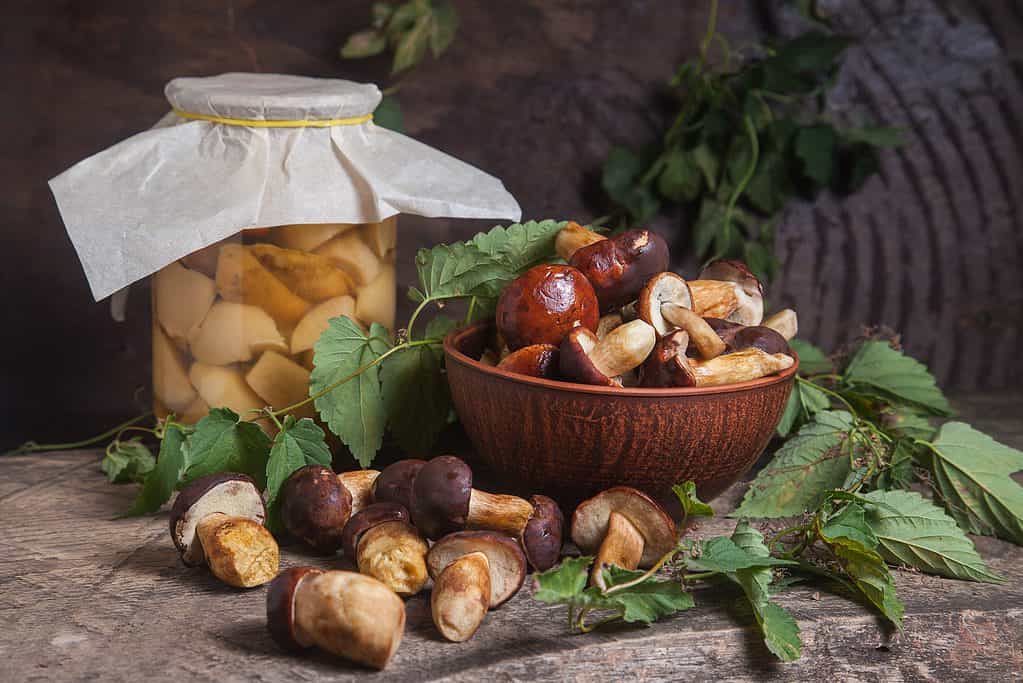
You can find the bay bolete growing under or near its host trees, which are often conifers such as pine and Eastern hemlock.
©Kostiantyn Kravchenko/Shutterstock.com
The bay bolete (Imleria badia) is a good edible mushroom that you can commonly find in its growing regions. Like the vast majority of boletes, this mushroom is mycorrhizal, meaning it establishes a beneficial plant-fungi partnership. The mycelium of the bolete provides the roots of its host tree essential nutrients like phosphorus and nutrients, while the plant provides the fungus metabolites like sugar.
While it’s not as famous as the king bolete (Boletus edulis), it’s nonetheless a great edible that you can often find easier and in larger numbers than B. edulis. A common manner to cook this mushroom is by pan-frying it with butter, garlic, and lots of shallots.
To identify: You can find the bay bolete growing under or near its host trees, which are often conifers such as pine and Eastern hemlock. In Europe, these mushrooms also commonly grow under beech trees. Like most boletes, the bay bolete contains pores under the cap, rather than gills. These pores are a pale yellow to olive color and they bruise bluish-grey when pressed. The spongy, reddish-brown cap typically reaches up to 3.5 inches across, is convex when young, and becomes more broadly convex as it matures. The pale yellow to reddish-brown stipe is swollen at the base, tapering in towards the cap. It usually reaches up to 7 inches tall and can be up to 1.5 inches thick. The flesh is white and bruises a light blue or blue-pink near the pores.
4. Jelly Ear Mushroom (Auricularia americana)
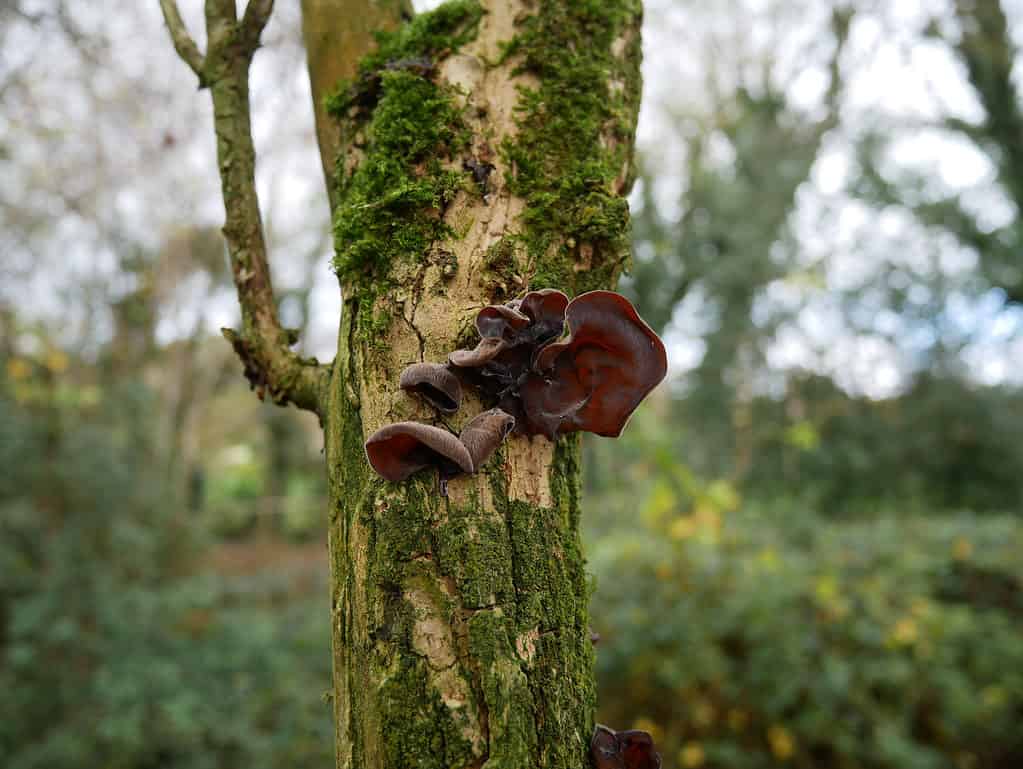
This gelatinous, wrinkled, or smooth, often ear-shaped mushroom can grow alone or in large colonies on fallen parts of hardwood trees.
©Brapaceae/Shutterstock.com
The jelly ear or wood ear mushroom (Auricularia americana) is an edible, brown jelly fungus. Its close relative to some other species that are widely popular for use in many East Asian dishes. Chinese hot and sour soup is a well-known dish that often contains the wood ear. The American species, with its similar taste (typically mild) and texture, does quite well in comparable dishes.
To Identify: You can find this whimsical-looking saprobic mushroom growing on decaying hardwood from spring through fall throughout temperate, arboreal regions of North America. The common name, jelly ear, aptly describes the appearance of Auricularia americana. This gelatinous, wrinkled, or smooth, often ear-shaped mushroom can grow alone or in large colonies on fallen parts of hardwood trees. The fruiting body does not contain a stipe and features a thin brown to reddish-brown cap that can grow up to 2 inches across. There are similar-looking mushrooms in the genus Exidia that people will often mistake for wood ear, luckily they are equally as edible.
When fresh, the texture of the mushroom is gelatinous to rubbery. When dry, this mushroom is hard, brittle, and closer to black. The spore-bearing tissue under the cap is typically smooth or wrinkled, with no visible pores or gills.
Summary of 4 Types of Brown Mushrooms
| Number | Brown Mushroom | Scientific Name |
|---|---|---|
| 1 | Shiitake Mushroom | Lentinula edodes |
| 2 | Hen of the Woods Mushroom | Grifola frondosa |
| 3 | Bay Bolete | Imleria badia |
| 4 | Jelly Ear Mushroom | Auricularia americana |
The photo featured at the top of this post is © itchima/Shutterstock.com
The information presented on or through the Website is made available solely for general informational purposes. We do not warrant the accuracy, completeness, or usefulness of this information. Any reliance you place on such information is strictly at your own risk. We disclaim all liability and responsibility arising from any reliance placed on such materials by you or any other visitor to the Website, or by anyone who may be informed of any of its contents. None of the statements or claims on the Website should be taken as medical advice, health advice, or as confirmation that a plant, fungus, or other item is safe for consumption or will provide any health benefits. Anyone considering the health benefits of particular plant, fungus, or other item should first consult with a doctor or other medical professional. The statements made within this Website have not been evaluated by the Food and Drug Administration. These statements are not intended to diagnose, treat, cure or prevent any disease.
Thank you for reading! Have some feedback for us? Contact the AZ Animals editorial team.



